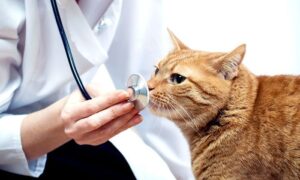By Beth Leermakers
I spent Saturday night in the parking lot at a 24-hour vet clinic. Fun times! Then, because I was fourth in line for emergency cases without appointments, and the vet was tied up with an emergency surgery that could take hours, I went back on Sunday morning.

Photo courtesy of Tumblr
My foster dog Gucci, who is terribly anxious around all new people — not just veterinarians — somehow tore a gaping hole in his side on Saturday afternoon. Murphy’s Law dictates that dogs will only seriously hurt themselves when your vet’s office is closed. An emergency vet visit is always stressful, but it’s even more so when your dog won’t let anyone get within six feet of him — let alone touch him — and you’re not allowed to accompany your dog into the exam room due to COVID-19. Fortunately, I had been working with a trainer who taught me how to get Gucci used to wearing a muzzle without fighting it. And I had a small stash of an anxiolytic medication that acts as a mild sedative. Armed with these aids, Gucci had a successful, albeit expensive experience — at least until he immediately pulled off his e-collar — essential to keep him from removing his bandage and tearing out his stitches. The joys of pet parenthood.
I hope you won’t ever have to take your pet to the emergency vet. However, it’s wise to be prepared, since many dogs and cats require veterinary care for an illness or injury at least occasionally.
Should You Take Your Pet
to the Vet Immediately?
With COVID-19 cases surging, and the need for social distancing, many vets recommend only going to the animal clinic or hospital if your pet is ill. Pet parents should postpone routine visits until a safer time. Some clinics offer telemedicine, allowing you to talk with your vet via video chat about minor or follow-up issues.
How do you know what requires immediate treatment, and what can wait?
Go to your vet clinic or emergency veterinarian immediately if your pet:
• Ate something toxic: human medications, chocolate, xylitol (artificial sweetener), antifreeze, rat poison, raisins, etc. Quickly refer to the list of poisonous substances at petpoisonhelpline.com, and call poison control immediately at 888-426-4435.
• Has an open wound
• Seems to be in pain
• Is having trouble breathing
• Suddenly shows signs of lameness or weakness
• Is having difficulty urinating (especially cats)
• Has prolonged vomiting and diarrhea (especially if you see blood), or any severe distention of the abdomen
• Shows neurologic signs, seizures, tremors, stumbling, circling, being disoriented
• Has an abnormal appearance or behavior, such as pale gums, bruising of the body, bulging eyes, squinting eyes, holding head to one side
• Has facial swelling or hives
• (Your cat) has not eaten in more than one day or is looking yellowish (jaundice)
Call your veterinarian about coming in if your pet:
• Has vomited once or twice in 24 hours
• Has had diarrhea for less than 24 hours but is acting normally
• Is coughing without signs of labored breathing
• Is sneezing and has watery eyes
• Has not eaten for more than 24 hours
• Is itching or shaking ears
Schedule an appointment later if your pet:
• Needs annual exams or routine bloodwork. However, if your pet is due for her rabies shot, you should see the vet now. Years ago, when my usually non-aggressive dog bit my neighbor, my dog’s current rabies certificate kept him from being quarantined at a local shelter.
• Has new lumps or bumps without showing signs of discomfort
Call your vet clinic to determine when you can come in and what safety protocols they are following. Ask:
• Will I be able to be with my pet during the exam? Some clinics may allow you to accompany her (while wearing a mask).
• Will you come to my car to get my pet? Curbside service is fairly typical now. You will probably stay in your car while a vet tech collects your pet. Because Gucci is so fearful, I put on his muzzle and walked him to the door (wearing my mask).
• How will I communicate with the doctor? I spoke by phone with the vet receptionist about Gucci’s wound and special needs. Then I spoke with the vet several times regarding the exam findings, treatment plan and follow-up care.
• Will you take payment over the phone? You may need to produce your credit card.
How to Prepare for an Emergency Vet Visit
Locate alternate vet clinics in case your regular vet’s office is closed. There are a few “regular” (non-emergency) vet clinics in the DFW area that are open 24 hours a day, 365 days a year. These clinics may be less expensive than emergency hospitals. Alternate clinics will send all the treatment records to your usual vet.
Ask your regular vet for a copy of your pet’s medical records. You’ll need to take those records, including vaccination history, to the alternate vet.
Make sure your credit card information is on file, in case a friend or relative takes your dog to the vet (if you’re sick).
Assemble a pet emergency kit so you can handle minor first aid at home. I was fortunate to have Trazodone on hand, so I could administer the sedative before heading to the vet.
Get your cat used to the carrier, or your dog used to a muzzle, ahead of time. Forcing a scared cat who’s in pain into a carrier will increase everyone’s stress.
By following these steps, you can reduce the stress of an unexpected vet visit.
